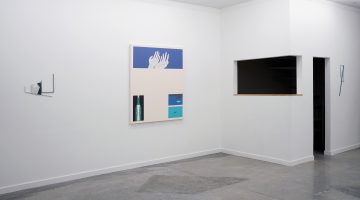Amanda Curreri’s “The Aunque,”“even though” in Spanish, at Romer Young Gallery shows pieces of the complicated history of the gay rights movement. A flag with two colors that were commercially unreproducible from Gilbert Baker’s handmade 1978 eight color Rainbow Flag, turquoise and hot pink, is a sign for the primarily abstract show. There is no tidy way to present history, so Curreri paints in a way that reveals the layers and interweaving of its composition. Blue, green, yellow, and lavender are simultaneously energizing and a promise that everything will work out. She describes this style as Active Formalism, creating a reflexive experience for the viewer through the work’s formal composition. Truths can be discordant with other truths, and to force an explanation is missing the point.

Amanda Curreri. Misfits, 1979 (Sex and Art), hand-dyed, screenprinted and sewn fabric; powder-coated aluminum, 77"x48", 2013.
A sandwich board shrine to Jean Genet, writer, political activist, self-professed outlaw, and pioneer of gay identity, is ready for Curreri’s performance “Jean Genet in the Aunque” on January 30. One side is plastered with a 1964 interview Genet gave to Playboy magazine, the other side is offerings and scripts. The “even though” of Jean Genet is that he was an admirable human even though a lot of himself was embellished to caricature; he supported activist groups for marginalized people (Black Panthers, Red Army Faction) even though they committed murder in the name of their cause; he wrote profound sentences, even though he often comes off as melodramatic. This is the only visual hint about the meaning of Curreri’s meditative lines of color; their titles are overt or referential to other homosexual trailblazers, like Violette Leduc, La Bâtarde (The Bastard), “My Desire, My Refuge, My Catastrophe.”
“Black Swans” is a screen print on vertically slashed canvas. The black swan theory is when a momentous event catches you off guard (a black swan rather than a white one), and, through hindsight, you incorrectly rationalize the event as foreseeable. Genet refused to give his homosexuality a black swan theory in Playboy, saying, “As for being homosexual, I can’t tell you why I am… Does anyone know why one is a homosexual?” Asking a writer whose primary subjects were homosexuality and petty crime in the 1960s was fishing for a story of perversion and abuse. Though Genet identified with all types of “others,” explaining something as natural as sexuality would have confirmed his status as inferior “other”—heterosexual people aren’t asked why they prefer the opposite sex. Jean-Paul Sartre famously tried to give Genet’s writing a black swan theory in “Saint Genet,” in which he argued, using Genet as the example, that genius is a savoir to poor circumstance, rather than an innate gift. Sartre’s dismissal could have been aimed at any “other” group.
There will be a time when homosexuality will be seen as trivial, and when it doesn’t matter, it will be momentous. Amanda Curreri’s graphic sensibility and beautiful hues are a fitting tribute to artists of the past who are helping us get there.
Amanda Curreri’s “The Aunque” is on view at Romer Young Gallery though February 16, 2013.
-Kendall George





